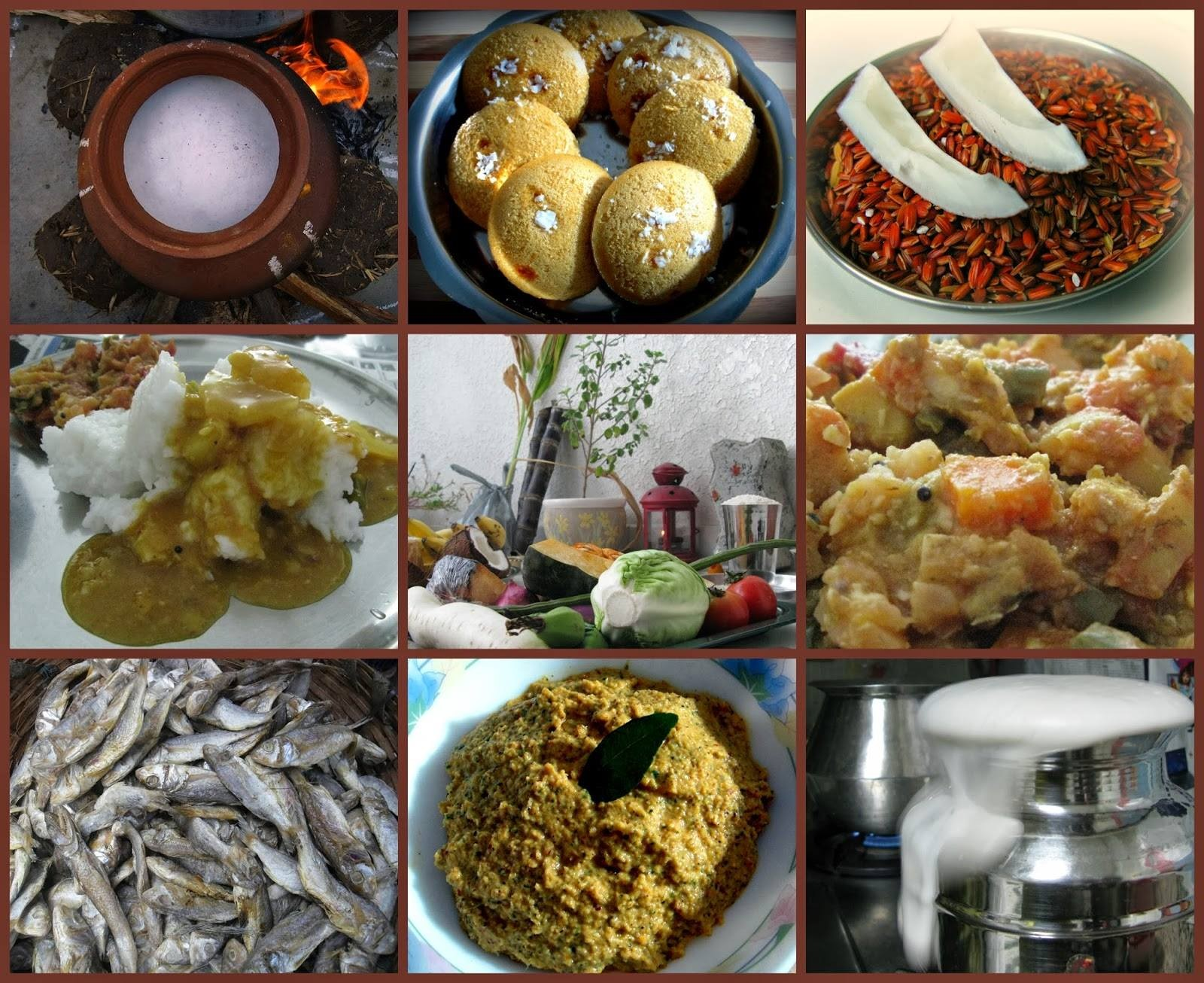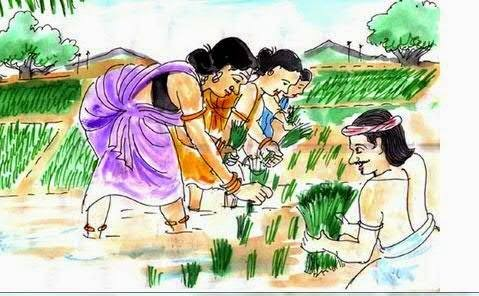"FOOD HABITS OF TAMILS" PART:23 "பண்டைய சங்க தமிழரின் உணவு பழக்கங்கள் தொடர்கிறது" / "Food Habits of Ancient Sangam Tamils continuing" [தமிழிலும் ஆங்கிலத்திலும் / In English and Tamil]
சங்கத் தமிழரின் உணவு மரபை ஒரு இள மனைவியின் கதையாகவே
கொடுக்கிறது கி மு 200 ஆண்டை சேர்ந்த குறுந்தொகை 167. “முளிதயிர் பிசைந்த காந்தள் மெல்விரல்,
கழுவுறு கலிங்கங் கழாஅ துடீஇக், குவளை யுண்கண் குய்ப்புகை கமழத், தான் றுழந் தட்ட தீம்புளிப்
பாகர், இனிதெனக் கணவ னுண்டலின், நுண்ணிதின் மகிழ்ந்தன் றொண்ணுதன் முகனே.” என்று. மேலும் அந்த இளம் குடும்பப் பெண் தித்திக்கும் புளிச்
சுவை நிறைந்த மோர்க் குழம்பை அல்லது புளிக் குழம்பை ஆக்குவதில் கொண்டிருந்த ஆழமான ஈடுபாட்டை
ஒவ்வொரு வரிகள் ஊடாகவும், அதே நேரம் அந்த உணவு ஆக்கும் முறையையும் நாம் அதில் அறிய
முடிகிறது. தலைவனும் தலைவியும் பிறர் நன்கு அறியாத படி மறைவாக கண்டு காதல் கொண்டு,
பெற்றோரின் சம்மதம் இன்றி, களவு மணம் செய்து இருவரும் தனிக் குடித்தனம் சென்றனர். துடித்துப்
போனாள் மணப் பெண்ணின் தாய். பொறுப் பேதுமின்றி, செல்வச் செழிப்புடன், உலாவித் திரிந்தவளால்
தனக் குடித்தனம் நடத்த முடியுமா? அடுப்பங்கரையே தெரியாதவள் எப்படி ஆக்கிப் போடுவாள்?
அமைதி கொள்ள முடியாத தாய், தன் தோழியை அழைத்து மகளின் தனிக் குடித்தனத்தின் சிறப்பை
கண்டு வருமாறு கேட்டுக் கொண்டாள். அதன் படி, எப்படி இல்லறம் நடத்துகிறாள் என்பதைப்
பார்க்கப் போன செவிலிக்குக் கிடைத்த அருமையான காட்சி இங்கு கவிதையாகிறது.
தலைவன் வெளியே சென்று விட்டான், தன் தலைவனுக்காக
உணவு ஆக்கும் பணியில் இறங்கினாள் அந்த இளம் தலைவி. முதல் காட்சியில் தலைவி சமையல் செய்கிறாள்.
நன்கு முற்றிய கட்டியாகியிருந்த தயிரை உறியிலிருந்து இறக்கி எடுத்து, அந்த கெட்டித்
தயிரை தன் மெல்லிய விரல்களால் பிசைகிறாள்; அவ்வேளை, அவள் திடுமென எழுகிறாள். அப்பொழுது,
அவள் அணிந்திருந்த சேலை நழுவி விட்டது. கை கழுவிப் பின் சேலையைச் செருகி மீண்டும் தயிரைத்
தொட்டால் தயிரின் பதம் கெட்டு விடும் என்பதால், அது அழுக்காகி விடும் என்று தெரிந்தும்,
உடனே தயிர் பிசைந்த கையால் பற்றி ஆடையை உடுத்துக் கொள்கிறாள். நெய்யோடு கடுகு மிளகு
என்பன இட்டுத் தாளித்துப் பின் பிசைந்த தயிர் ஊற்றி மோர்க் குழம்பு செய்தாக வேண்டும்.
அப்படி முறைப்படி தாளிக்கும் போது, கடுகும்
மிளகும் இன்ன பிறவும் நெய்யில் வதங்கிப் பொரிய, புகை பொங்கி எழுந்தது, கண்களில் புகை
நிறைகிறது; எனினும் அதனை அவள் பொருட் படுத்தாது கண்ணைக் கசக்கியபடி துழாவி துழாவி இதமாகச்
சமைத்தாள். தாளித்த [கறி] சட்டியை விட்டு அவள் விலகவே யில்லை. சற்றே விலகினாலும் சுவை
மாறி விடும் என்பதால். இவ்வாறு புளிக் குழம்பு செய்து முடிக்கிறாள் தலைவி. அடுத்த காட்சியில்
தலைவன் உண்டு கொண்டிருக்கிறான். ‘இனிது’ என்கிறான். தலைவியின் முகத்தில் சொல்ல முடியாத
மிக நுட்பமான மகிழ்ச்சி பரவுகிறது. செவிலி வருணிக்கும் காட்சியில் கேட்கும் ஒரே பேச்சுக்
குரல் தலைவன் சொன்ன “இனிது” என்ற ஒற்றைச் சொல்தான். மற்றபடி இது அன்பினால்
இயக்கப் பட்ட ஒரு மௌன நாடகம் ஆகும்.
தமிழில் எழுதப்பட்ட சமையல் நூல் ஒன்று சங்க காலத்தில்
இருந்ததாக சிறுபாணாற்றுப்படை, வரிகள் 238 - 241, “கா எரியூட்டிய கவர் கணைத் தூணிப்,
பூ விரி கச்சைப் புகழோன் தன்முன், பனிவரை மார்பன், பயந்த நுண் பொருள், பனுவலின் வழாஅப்
பல் வேறு அடிசில்," குறிப்பிடுகிறது. அதில், ஒய்மான் நாட்டு மன்னனான நல்லியக்கோடன்
[இவன் சங்ககால வள்ளல்களில் ஒருவன்] பாணர்களுக்கு விருந்து படைக்கும் போது இந்த நூலிலுள்ள
முறைமை வழுவாமல் சமைக்கப் பட்ட உணவை இட்டானாம் என்கிறது. இந்த நூல் அருச்சுனனின் அண்ணன்
வீமனால் எழுதப் பட்டதாம். ஆகவே இது வடமொழி நூலைத் தழுவியதாக இருக்கலாம். எனினும் இலக்கியத்
தொகுப்பிற்கு முன்பாகவே இந்நூல் அழிந்து விட்டது போலும். இரண்டாயிரம் ஆண்டுகளுக்கு
முன்பே சமையல் தொடர்பாகத் தனித்துவமான ஒரு நூல் இருந்தது என்ற செய்தியால், நாம் அக்கால
தமிழரின் உணவு மரபின் சிறப்பைக் காணக் கூடியதாக இருக்கிறது.
மேலும் அங்கு காணப்பட்ட உணவு மரபு வளர்ச்சியின்
உன்னதமான நிலை, வீடுகள் தோறும் தனியாக ‘சமையலறை’ என்று ஒன்று அமைய காரணமாக இருந்திருக்க கூடும்.
அவற்றை அட்டில் என சங்க தமிழர் அழைத்தனர். அது மட்டுமா, மிக நுணுக்கமாக உணவருந்தும்
முறைகளை ஆய்வு செய்து, அதன் அடிப்படையில் பொருத்தமாக உணவு உண்ணும் பன்னிரெண்டு முறைகளை
தந்துள்ளார்கள் என்பதும் அவர்களின் அக்கால உணவு மரபின் சிறப்பைக் காட்டுகின்றது.
அருந்துதல் - மிகச் சிறிய அளவு உட்கொள்ளல், உண்ணல்
- தாராளமாக பசிதீர உட்கொள்ளல். உறிஞ்சல் - வாயைக் குவித்துக்கொண்டு திரவத்தை உறிஞ்சி
உட்கொள்ளல். குடித்தல் - திரவ உணவை (கஞ்சி போன்றவை) மெல்ல மெல்ல பசி போக்க உட்கொள்ளல். தின்றல் - தின்பண்டங்களை உட்கொள்ளல்.
துய்த்தல் - மகிழ்ந்து,சுவைத்து உட்கொள்ளுதல். நக்கல் - நாவினால் துலாவி உட்கொள்ளுதல்.
நுங்கல் - முழுவதையும் ஓர் வாயில் ஈர்த்துறிஞ்சி உட்கொள்ளுதல். பருகல் -திரவிய பண்டத்தை
சிறுகக் குடிப்பது. மாந்தல் - பெருவேட்கையுடன் மடமடவென்று உட்கொள்ளுதல். மெல்லல் -
கடிய பண்டத்தைப் பல்லால் கடித்துத் துகைத்து உட்கொள்ளுதல். விழுங்கல் - பல்லுக்கும்
நாக்குக்கும் இடையே தொண்டை வழி உட்கொள்ளுதல் ஆகும்.
நன்றி
[கந்தையா தில்லைவிநாயகலிங்கம், அத்தியடி, யாழ்ப்பாணம்]
பகுதி : 24 தொடரும்
👉அடுத்த பகுதியை வாசிக்க அழுத்துக-
Theebam.com: "தமிழரின் உணவு பழக்கங்கள்" -பகுதி: 24
👉ஆரம்பத்திலிருந்து வாசிக்க அழுத்துக
Theebam.com: "தமிழரின் உணவு பழக்கங்கள்"பகுதி: 01:
"FOOD HABITS OF TAMILS" PART: 23
"Food Habits of Ancient Sangam Tamils continuing"
Kuzhambu (குழம்பு / curry), is a dish common
in South Indian and Sri Lankan Tamil cuisines, and is a gravy based on a broth
made with tamarind, urad (bean) dal and toor dal, and can include vegetables.
The dish is very popular as a side for rice among Tamils. The number of
varieties of kuzhambu are countless, one of which is a tamarind based gravy,
puzhi kuzhambu, which people ate even 2200 years ago! It is a thick gravy with
tamarind pulp. It has a tangy flavour combined with the special spices. We
found this curry in Kurunthokai 167 [2nd century B.C], penned by Koodalur
Kizhaar. The verse is situated in the forest regions of ‘Mullai’ and speaks in
the voice of the lady’s foster-mother to the birth-mother, narrating events
that transpired in the lady’s marital home. The verse opens with the words ‘முளி
தயிர் பிசைந்த’ meaning ‘kneading well-set curd’ and talks
about a well-known food item in Indian cuisine, known as ‘curd’ here, and goes
by the alias of ‘yoghurt’ in an international scene, which purists will declare
as different. Whatever that may be, here’s an evidence of the usage of curd,
known for its probiotic wealth, in Sangam times. Next, the final dish being prepared
appears in ‘தீம் புளிப் பாகர்’ meaning ‘sweet and sour gravy’.
What is really cooking in this verse? The
context reveals that Hero & Heroine have fallen in love and without parents
consent. They have eloped and married. After few days the girl's parents send
the foster mother to check out if the girl is doing well & happy. The
foster mother goes to her place and observes and reports back to their parents.
So this situation usually results in poem of how the young girl has taken up
responsibility of running the family and how she does really well even though
she is young and used to luxurious conditions in her parents home. Here is the
poem where the foster mother recounts her observations to Heroine’s
mother. “After kneading the thick curd
with her flame-lily-like, soft fingers, as her well-washed attire slipped away,
even without washing her fingers, she touched her attire and wore it. With her
blue-lily-like, kohl-streaked eyes, filled with cooking smoke, she served the
sweet and sour curry that she stirred on her own to her husband, who savouring
it, declared it to be delicious. Hearing that, a subtle joy spread on that
face, decked with a luminous forehead.” With these words, the foster-mother
passes on the news to the birth-mother that their daughter is leading a happy
life with her husband.
Sangam poem, Sirupanatruppadai, which were
written by the poet Nathattanaar in praise of a minor Velir chieftain named
Nalliyakkotan, a Naka king of Naka Nadu (ancient Malabar North Ceylon) -
mentioned that there were cook book in Tamil during Sangam period, may be
written based on sanskrit [saṃskṛtam] book, wrote by Bhima of mahabharata. It
is also understand from Mahabharata that he is the first to have cooked a dish
much loved in South India, Aviyal, which is a thick stew of vegetables, curd
and coconut, While he served at the court of King Virata as disguise himself as
a cook named Vallabha.
"He will serve you many different foods
that have been created from cookbooks written by Bheeman with a chest like that
of a snow-covered mountain, older brother of Arjunan who wears a
breast cloth with flower designs, famed for
his archery skills, the one who received a quiver with arrows from the fire god
after burning a forest." [Sirupanatruppadai: 238-241] It is surprised to
understand that during the Sangam period or even before that every Tamilian
houses had separate kitchen called attil [அட்டில்] and further We come to know
from Sangam literature that ancient Tamilian consumed food or drink in twelve
different ways. They are
Arunthuthal [அருந்துதல்] - consuming very very little like medicine,
Unnal [உண்ணல்] - eating, Urinchal [உறிஞ்சல்] - suction, Uudiththal [குடித்தல்]
- Drinking, Thinral [தின்றல்] - eating, tuyttal [துய்த்தல்] - Eating anything
with satisfaction or pleasure, Nakkal [நக்கல்] - Things eaten by licking,
Nunkal [நுங்கல்] - devouring, parukal [பருகல்] - drinking, liquid food, maantal
[மாந்தல்] - eating drinking, Mellal [மெல்லல்] - Mastication or chewing -food is
crushed and ground by teeth and, vilunkal [விழுங்கல்] - deglutition
Thanks
[Kandiah Thillaivinayagalingam,Athiady, Jaffna]
PART : 24 WILL FOLLOW















0 comments:
Post a Comment